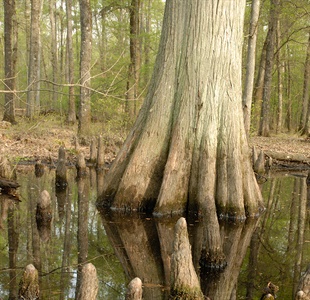The Arkansas Natural Heritage Commission (ANHC) recently closed on a 678.4-acre addition at Falcon Bottoms Natural Area (NA). Falcon Bottoms NA is located in three counties in the Coastal Plain: Columbia, Lafayette, and Nevada.
The new tract is located on the south side of the natural area and protects an additional 1.9 miles of Bayou Dorcheat, a high-quality Coastal Plain stream, and its associated natural communities. This tract also provides additional public access to the southern end of the property for birding, hiking, hunting, and fishing opportunities.
Most of Falcon Bottoms NA is occupied by a bottomland forest community dominated by willow oak and overcup oak in the seasonally flooded areas and bald cypress in the wetter areas. High knolls and terraces support a lowland pine-oak forest community. Bayou Dorcheat is one of the most intact and important Arkansas streams west of the Ouachita River.
The relatively unaltered landscape of the bottomlands, as well as the associated rare species and natural communities found along Bayou Dorcheat contribute to the need to protect the area. The brown madtom (Noturus phaeus), dwarf salamander (Eurycea quadridigitata), Sebastian-bush (Ditrysinia fruticose), crested-coralroot (Hexalectris spicata var. spicata), Curtiss’ star-grass (Hypoxis curtissii), and rein orchid (Platanthera flava) are species of conservation concern that are found within the natural area.
Funding for the approximately $1 million addition comes from the ANHC’s share of the Arkansas Natural and Cultural Resources Council grant. A grant from the Land and Water Conservation Fund, a National Park Service grant administered by Arkansas State Parks, contributes $250,000 toward the acquisition.
Falcon Bottoms NA was added to the state System of Natural Areas in 1991. The U.S. Fish and Wildlife Service holds a conservation easement on the area as a result of a North American Wetlands Council Act (NAWC) grant. This addition brings the size of the natural area up to more than 3,899 acres.
